Basketball Offense - 2-3 Man Offense
From the Coach’s Clipboard Basketball Playbook"Helping coaches coach better..."
Disclosure: This page contains affiliate links, which means that Coach's Clipboard receives a small commission (at no cost to you) if you make a purchase using these links.
Consider the 2-Out, 3-In offense if you have two or three strong inside post players, or if you do not have good outside shooters, or a good point guard. This offense is designed to be a deliberate, tempo-control offense that looks to get high-percentage inside shots.
The 3-point shot can be taken when open, but our main goal here is inside shots, post-moves, lay-ups, free-throws, and attacking the offensive boards for rebounds. Big strong teams usually don't like a fast-paced, running game and often tend to do better with a slower, tempo-controlled game. Players must be patient and value each possession. Game scores tend to be lower with this style of offense.
Here we present two basic patterns: a "2-3 Low" offense and a "2-3 High" offense. Either (both) can be used by simply having the point-guard call "High" or "Low". Both offenses have continuity and can be run patiently, indefinitely until the defense breaks down and a good inside shot is obtained.
2-3 "Low" Offense
This 2-3 low offense is somewhat similar to what Coach Bruce Pearl used to run at the University of Tennessee, although the offense I am presenting here is actually something we have seen at the high-school level. There is some similarity to the Flex offense, but unlike the Flex, the Flex down-screens are not used, and the "bigs" are kept inside with the guards outside. This offense has continuity, with the inside players continuously running the flex cut, as the ball is moved back and forth on top, or into the corner.If diagram A below, we see the basic set which is a two-guard offense with O1 and O2 on top, and our three inside players down low with O5 on the block and O3 and O4 starting in the corners. O1 passes to O2. This triggers O5 to back-screen for O4, and O4 makes the flex-cut either over or under the screen, whichever the defense allows. After screening, O5 seals the defender and immediately "shapes-up" (comes back) to the ball for a post-up. O2 could pass to either O4 or O5 inside. If the pass is not there, O5 moves out to the weak-side corner.
O2 could also pass to O3 in the corner. O3's options are: pass to the flex-cutter O4, shoot the outside shot, dribble-drive to the hoop, or pass back out to O2 (or skip-pass to O1).
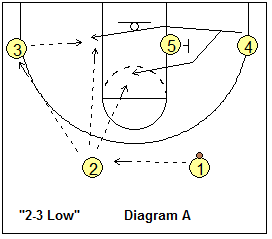
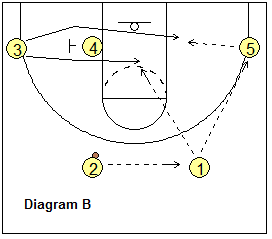
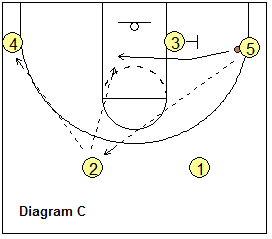
Diagram B shows O2 passing back to O1. This triggers O4 to back-screen for O3 as O3 makes the flex-cut. O4 seals and shapes-up to the ball. O1 could pass to either O3 or O4, or to O5 in the corner, or back to O2. Here we see O5 getting the pass in the corner (diagram C). O5 could shoot, pass to O3 inside, dribble-drive or pass back outside. Here O5 skip-passes back out to O2.
The skip pass to O2 triggers O3 to back-screen for O5, and O5 makes the flex-cut. Are you seeing the repetitive pattern here?
Teaching Point: Note that whenever a corner player dribble-drives the baseline, the post player on the ball-side block "I-cuts" up the lane line (to just below the ball-side elbow) to create spacing for the drive, and also for a possible dump-pass from the dribbler for a possible inside shot.
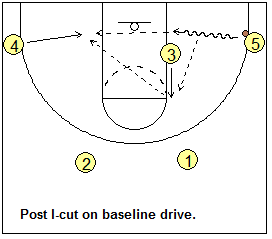
When the I-cutter O3 gets the pass (and the defense rotates), the opposite corner O4 basket-cuts, and could be open for a pass from O3, and a lay-up. But O4 should only cut if the ball goes to the I-cutter O3 - otherwise we like to keep O4 in the corner for the kick-out pass from the dribbler O5.
Diagrams D, E and F below show another option - you could call it a special play, or just allow it to run in the normal flow of your offense. O2 passes to O1. This time O5 and O3 set an inside "elevator" screen for O4. O4 cuts along the baseline, and then cuts up between O3 and O5 into the paint, as O3 and O5 close the elevator door. O1 passes to O4. O4 could have a quick turn-around jump-shot here, or could look to pass to either O3 or O5 posting up inside. O3 and O5 could also X-cut inside to further confuse the defenders.
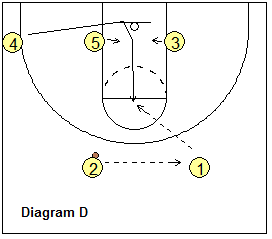
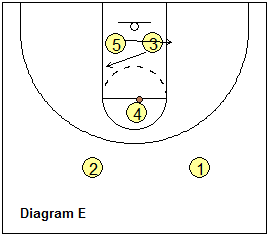
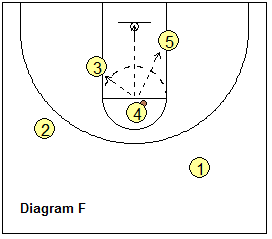
Diagrams G, H and I below show yet another option. You could call it a special play, or just allow it to run in the normal flow of your offense. O1 passes to O4 in the corner (diagram G). O4 could shoot or dribble-drive, or pass to the flex-cutter O3 (diagram H), or to O5 who cuts to the ball-side elbow after screening.
If O5 gets the ball, he/she could pass to O3 sealing inside (diagram I). O2 back-cuts and could get the pass from O5.
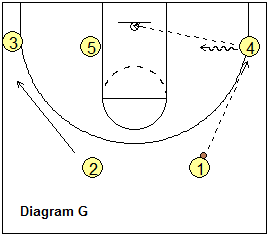
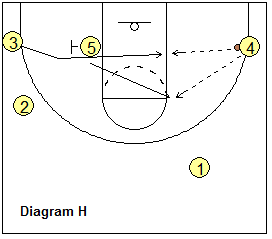
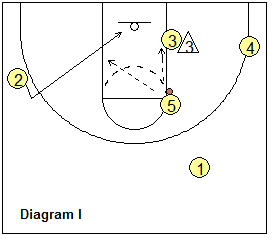
"Cyclone" Action
The 2-3 offense play was used by coach Fred Hoiberg. Diagram 1 shows that O1 passes to O3. O5 sets a flex-screen for O2, and O2 cuts hard and fast (either over or under the screen) and could get the pass from O3. O1 moves to the right wing and drifts to the corner. After screening for O2, O5 moves up to the elbow. O4 moves up to the left wing.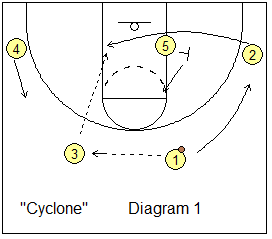
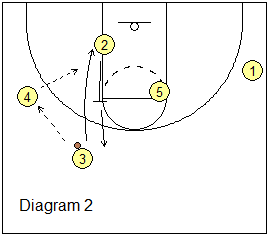
O3 passes to O4 (diagram 2) and O2 quickly moves up and sets a UCLA-screen at the left elbow. O3 makes the UCLA-cut and could get the pass from O4. Meanwhile, O2 moves to the top and gets the next pass from O4 (diagram 3). O5 ball-screens for O2. O2 and O5 run the high pick and roll, while O3 cuts up to the top ("roll and replace" action). O2 might score, or pass to O1 or back to O3 for open 3-point shots (diagram 4), or pass to O5 inside.
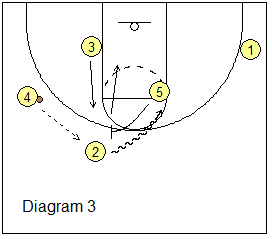
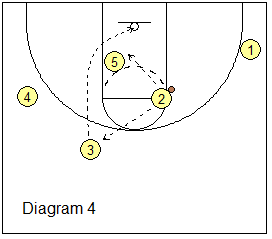
Coach Steve Forbes (East Tennessee State head coach): "Quick Hitting Transition Sets & Effective Out-of-Bounds Plays"
2-3 "High" Offense
The 2-3 "High" offense is also a two-guard offense. With the "High" offense, we bring our three inside players up to the free-throw line extended, with O3 in the middle, and O4 and O5 on the wings. Once again, this is a patient offense, looking for inside shots, lay-ups, post-moves and free-throws... (more details).See the complete article in the members section.
Sign up now!
The complete article also includes:
- 2-3 High Offense
- And a detailed Animation!